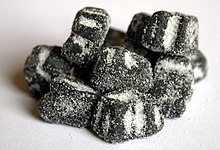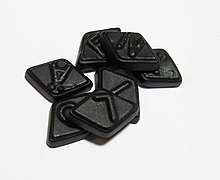 | |
| Alternative names | salmiak or salmiac liquorice |
|---|---|
| Type | confectionery |
| Course | Food |
| Place of origin | Northern Europe |
| Main ingredients | liquorice-root extract, salmiak salt (sal ammoniac; ammonium chloride), sugar, glucose syrup, modified starch, brown sugar syrup, maltodextrin, sometimes anise oil |



Salty liquorice, salmiak liquorice or salmiac liquorice, is a variety of liquorice flavoured with salmiak salt (sal ammoniac; ammonium chloride), and is a common confection found in the Nordic countries, Benelux, and northern Germany.[1] Salmiak salt gives salty liquorice an astringent, salty taste,[2] akin to that of tannins—a characteristic of red wines, which adds bitterness and astringency to the flavour. Consuming salmiak liquorice can stimulate either a savoury or non-savoury palate and response.[1] Anise oil can also be an additional main ingredient in salty liquorice. Extra-salty liquorice is additionally coated with salmiak salt or salmiak powder, or sometimes table salt.
Salty liquorice candy and pastilles are almost always black or very dark brown and can range from soft candy to hard pastille variety, and sometimes hard brittle. The other colours used are white and variants of grey. Salty liquorice or salmiak is also used as a flavouring in other products, such as ice creams, syrups, chewing gum, snus and alcoholic beverages.
- ^ a b Binelli, Mark (24 October 2018). "The Candy Issue: Salty Tooth". Proquest Digital Microfilm New York Times. The New York Times Magazine. ISSN 0362-4331.
- ^ "Salammoniac: Salammoniac mineral information and data". Mindat.org. Hudson Institute of Mineralogy.